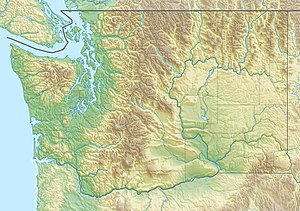Issaquah Creek
| Issaquah Creek | |
|---|---|
 Upper dam on Issaquah Creek | |
| Location | |
| Country | United States |
| State | Washington |
| County | King |
| Physical characteristics | |
| Source | Issaquah Alps |
| • coordinates | 47°26′41″N 121°59′28″W / 47.44472°N 121.99111°W[1] |
| Mouth | Lake Sammamish |
• coordinates | 47°33′43″N 122°3′52″W / 47.56194°N 122.06444°W[1] |
| Length | 13 mi (21 km)[2] |
| Basin size | 61 sq mi (160 km2)[3] |
| Discharge | |
| • location | USGS gage 12121600 at river mile 1.2[4] |
| • average | 130 cu ft/s (3.7 m3/s)[4] |
| • minimum | 6.2 cu ft/s (0.18 m3/s) |
| • maximum | 3,200 cu ft/s (91 m3/s) |
Issaquah Creek (Lushootseed: qʷaxʷ)[5] is a small stream flowing through the city of Issaquah and nearby communities, in the U.S. state of Washington. Its headwaters are on the slopes of Cougar, Squak, Tiger, and Taylor mountains in the Issaquah Alps. Tributaries of Issaquah Creek include Holder Creek, Carey Creek, Fifteen-mile Creek, McDonald Creek, East Fork Issaquah Creek, and North Fork Issaquah Creek. The creek empties into the south end of Lake Sammamish. The lake's outlet is the Sammamish River, which in turn empties into Lake Washington and ultimately Puget Sound.[3]
Issaquah Creek's drainage basin is over 75% forest land and less than 10% urbanized or cleared. The basin is one of the three most significant in urbanizing King County. The upper and middle portions of the basin have been identified as a Regionally Significant Resource area due to their exceptional fish habitat and undeveloped character. The entire basin is an important salmon migration and spawning area. Carry Creek and Holder Creek, in the upper Issaquah Creek basin, provide particularly excellent salmonid habitat.[3]
Every October people gather on its shores (especially during Issaquah's Salmon on Sunset celebration, which has several viewpoints staffed with Friends of Issaquah Salmon Hatchery FISH docents explaining the salmon run) to watch the salmon traveling upstream.[6] [7] and by the local Native Americans.[citation needed].
Issaquah Creek and its tributaries support Chinook, coho salmon (and resident kokanee), coastal cutthroat trout. Chinook and coho are reared by the state Issaquah Salmon Hatchery, located three miles upstream from the creek's mouth.[3] The hatchery has been releasing Chinook salmon into Issaquah Creek since 1936.[8] Each Spring the hatchery releases approximately 500k coho (April 1) and 2.7 million Chinook smolts (in May) have been released each year.[9]
See also
[edit]References
[edit]- ^ a b U.S. Geological Survey Geographic Names Information System: Issaquah Creek
- ^ Calculated in Google Earth
- ^ a b c d "Issaquah Creek Site 0631". King County Water and Land Resources Division. Retrieved August 5, 2009.
- ^ a b "Water-Data Report 2008, 12121600 Issaquah Creek" (PDF). USGS. Retrieved August 5, 2009.
- ^ Bates, Dawn E.; Hess, Thom; Hilbert, Vi (1994). Lushootseed dictionary. Seattle: Univ. of Washington Press. p. 189. ISBN 978-0-295-97323-4.
- ^ Cohen, Fiona (October 3, 2017). "See Salmon Run: Salmon-Spotting Places Around Seattle and the Eastside". KCTS 9 - Public Television. Retrieved March 23, 2018.[permanent dead link]
- ^ "Washington Sport Fishing Rules Pamphlet" (PDF). wdfw.wa.gov. December 22, 2016. Retrieved March 22, 2018.
- ^ "History of the Issaquah Salmon Hatchery – Friends of the Issaquah Salmon Hatchery". www.issaquahfish.org. Retrieved March 23, 2018.
- ^ "Timing, abundance, and population characteristics of spawning Chinook salmon in the Cedar/Sammamish Watershed" (PDF). King County. Retrieved August 5, 2009.
Further reading
[edit]- Manning, Harvey. 50+ Trails of Cougar Mountain Regional Wildland Park, Squak Mountain State Park, Lake Sammanmish State Park, Coal Creek Park, May Creek Park.Issaquah: Issaquah Alps Trails Club, 1985.
External links
[edit]- Issaquah Creek Subarea Map, King County Water & Land Resources Division
- Issaquah Creek Basin Map, King County DNRP/WLR GIS


